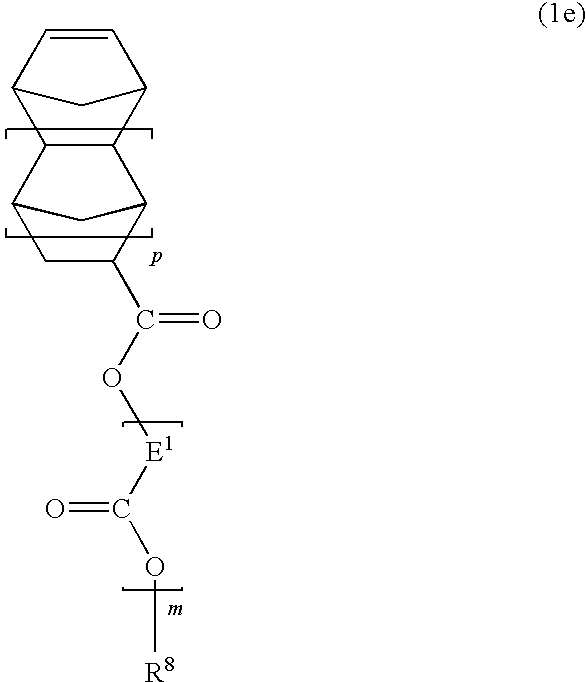Process for producing photoresist polymeric compounds
a polymer compound and photoresist technology, applied in the field of photoresist polymeric compound production, can solve the problems of not showing desired properties as resists, adversely affecting the electrical properties of semiconductor devices, and giving a polymer sufficiently reduced in iron content, etc., to achieve low sodium content, low content of metal components, and low production cost
- Summary
- Abstract
- Description
- Claims
- Application Information
AI Technical Summary
Benefits of technology
Problems solved by technology
Method used
Image
Examples
example 1
[0128]Production of Photoresist Polymeric Compound with Following Structure
[0129]In a reactor equipped with a stirrer, a thermometer, a reflux condenser, a dropping tube, and a nitrogen inlet tube, was placed 70 g of propylene glycol monomethyl ether acetate (PGMEA). After elevating the temperature to 100° C., a solution mixture was added dropwise over 6 hours. The solution mixture was a solution containing 73.0 g of 5-methacryloyloxy-2,6-norbornanecarbolactone (MNBL) (metal content of 100 ppb or less), 77.0 g of 2-methacryloyloxy-2-methyladamantane (2-MMA), and 1.8 g of azobisisobutyronitrile in 530 g of PGMEA. After the completion of dropwise addition, the resulting mixture was aged for 2 hours and thereby yielded a polymer solution containing 20 percent by weight of a polymeric compound represented by the above formula. The polymer solution was filtrated through a membrane filter having a pore diameter of 0.5 μm, and the filtrate was combined with 750 g of methyl isobutyl ketone ...
example 2
[0133]A polymer solution was obtained through polymerization by the procedure of Example 1, except for using a commercially available PGMEA as intact. The polymer solution was passed through a membrane filter having a pore diameter of 0.5 μm, and combined with 750 g of a commercially available methyl isobutyl ketone (MIBK). The polymer solution at this stage had a content of metals of 1200 ppb.
[0134]The polymer solution was then subjected to a washing treatment by adding 1500 g of water (ultrapure water), stirring, and separating the mixture into an organic layer and an aqueous layer. The organic layer at this stage had a content of metals of 250 ppb. The organic layer was first passed through “IonKleen AN Purifier” (trade name; supplied by Pall Corporation, made from a polypropylene, with a filtration area of 0.093 m2) including a porous polyolefin membrane having an anion-exchange group. This was performed at room temperature and a flow rate of 100 grams per minute. The solution w...
example 3
Production of Photoresist Polymeric Compound with Following Structure
[0139]
[0140]In a reactor equipped with a stirrer, a thermometer, a reflux condenser, a dropping tube, and a nitrogen inlet tube, was placed 70 g of propylene glycol monomethyl ether acetate (PGMEA). After elevating the temperature to 100° C., a solution mixture was added dropwise over 6 hours. The solution mixture was a solution containing 50 g of 5-methacryloyloxy-2,6-norbornanecarbolactone (MNBL) (metal content of 100 ppb or less), 50 g of 2-methacryloyloxy-2-methyladamantane (2-MMA), 50 g of 1-hydroxy-3-methacryloyloxyadamantane (HMA), and 1.8 g of dimethyl 2,2′-azobis(2-methylpropionate) (initiator; supplied by Wako Pure Chemical Industries Ltd. under the trade name V-601) in 530 g of PGMEA. After the completion of dropwise addition, the resulting mixture was aged for 2 hours and thereby yielded a polymer solution containing 20 percent by weight of a polymeric compound represented by the above formula. The poly...
PUM
| Property | Measurement | Unit |
|---|---|---|
| Fraction | aaaaa | aaaaa |
| Time | aaaaa | aaaaa |
| Time | aaaaa | aaaaa |
Abstract
Description
Claims
Application Information
 Login to View More
Login to View More - R&D
- Intellectual Property
- Life Sciences
- Materials
- Tech Scout
- Unparalleled Data Quality
- Higher Quality Content
- 60% Fewer Hallucinations
Browse by: Latest US Patents, China's latest patents, Technical Efficacy Thesaurus, Application Domain, Technology Topic, Popular Technical Reports.
© 2025 PatSnap. All rights reserved.Legal|Privacy policy|Modern Slavery Act Transparency Statement|Sitemap|About US| Contact US: help@patsnap.com



